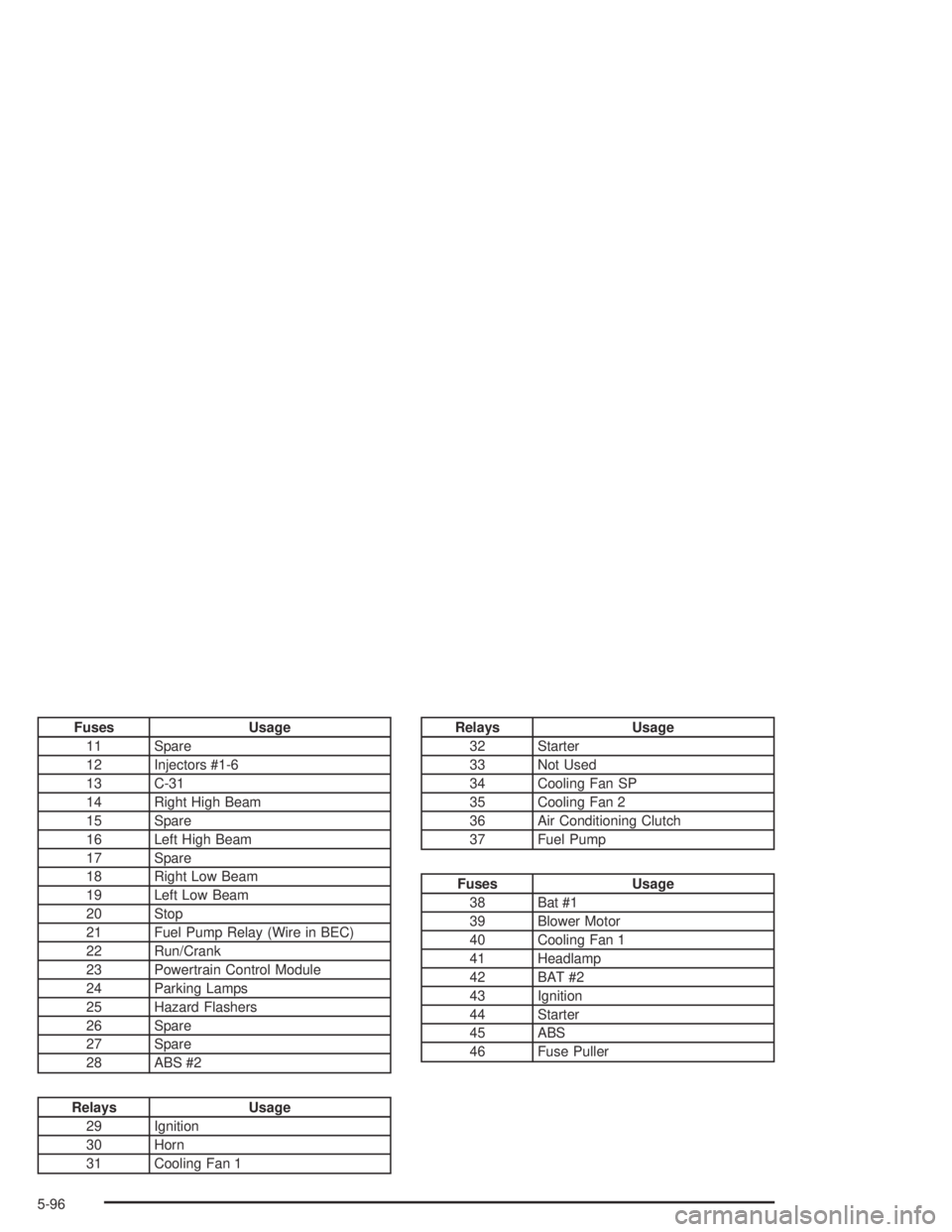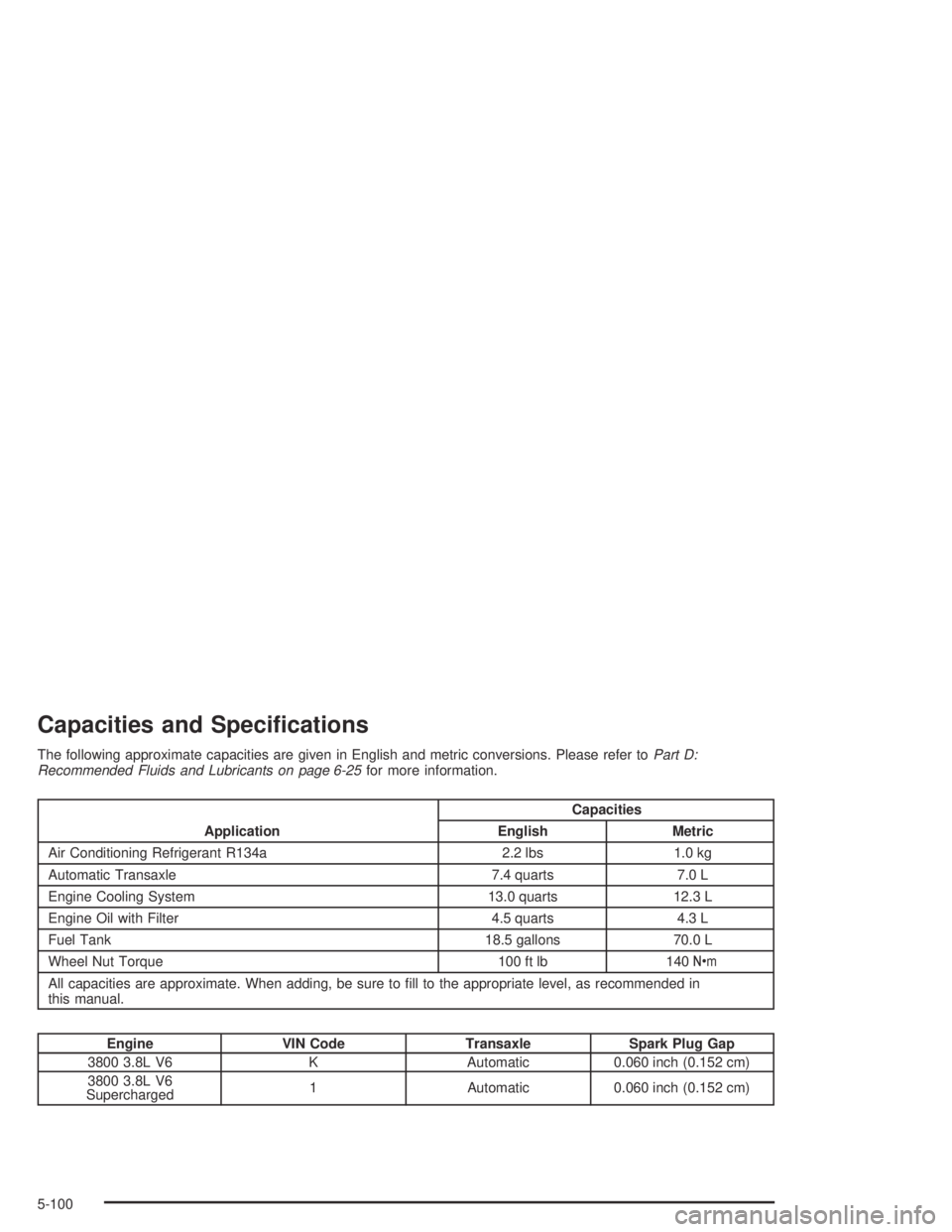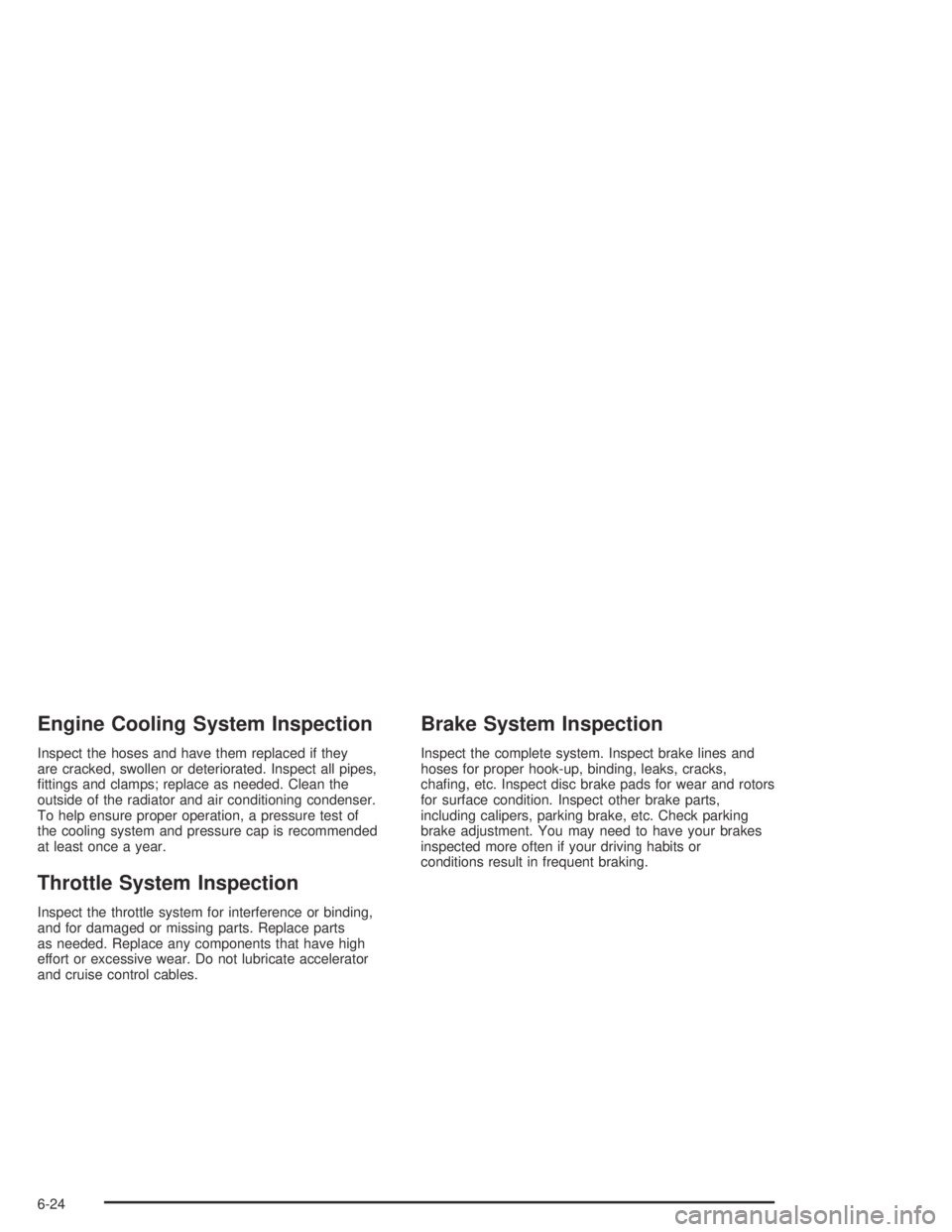2005 BUICK PARK AVENUE air conditioning
[x] Cancel search: air conditioningPage 141 of 388

AIR FLOW:Pressing the AIR FLOW button will display
and hold the current setting while in manual mode.
Use the up and down arrows on the AIR FLOW button
to cycle through the available modes.
WINDSHIELD-FLOOR:This mode directs most of
the air�ow to the windshield with some air�ow to
the outboard outlets (for the side windows) and the
�oor outlets.
MID:This mode directs air�ow through the
instrument panel outlets.
FLOOR-MID:This mode directs air�ow through
both the �oor and the instrument panel outlets.
There is also a small amount of air directed to the
windshield and the outboard outlets (for the
side windows).
FLOOR:This mode directs most of the air�ow to
the �oor outlets with some directed to the outboard
outlets (for the side windows) and the windshield.
OFF:Press the OFF button once to turn off the
passenger climate control, if it has been activated.
Pressing the OFF button a second time will turn off the
main system. The outside temperature will be shown
on the display when the system is off.VENT:Pressing the VENT button allows outside air to
�ow through your vehicle without the air conditioning
compressor working. To turn off the VENT selection,
push the VENT button again.
Selecting the VENT and AUTO buttons at the same
time allows the system to control the air�ow
automatically without using the air conditioning
compressor or the recirculation mode.
RECIRC (Recirculation):Press this button to limit the
amount of outside air coming into the vehicle. It can
be used to prevent outside air and odors from entering
your vehicle or to help heat or cool the air inside
your vehicle more quickly. Press this button to turn the
recirculation mode on or off. When the button is
pressed, an indicator light will come on. The recirculation
mode cannot be used with the FRONT defrost or
VENT mode.
On hot days, open the windows to let hot air escape;
then close them. This helps to reduce the time it takes
for your vehicle to cool down. It also helps the system
to operate more efficiently.
3-27
Page 142 of 388

For quick cool down on hot days, press the AUTO
button and the system will automatically enter
recirculation mode and the temperature will be at the full
cold position for maximum cooling.
Using these settings together for long periods of time
may cause the air inside of your vehicle to become too
dry. To prevent this from happening, after the air in
your vehicle has cooled, turn the recirculation mode off.
The air conditioning system removes moisture from
the air, so you may sometimes notice a small amount of
water dripping underneath your vehicle while idling or
after turning off the engine. This is normal.
Sensors
The solar sensor on your vehicle monitors the solar
radiation and the air inside of your vehicle, then uses the
information to maintain the selected temperature by
initiating needed adjustments to the temperature, the fan
speed and the air delivery system. The system may
also supply cooler air to the side of the vehicle facing the
sun. The recirculation mode will also be activated, as
necessary. Do not cover the solar sensor located in the
center of the instrument panel, near the windshield,
or the system will not work properly.
Defogging and Defrosting
Fog on the inside of windows is a result of high humidity
(moisture) condensing on the cool window glass. This
can be minimized if the climate control system is
used properly.
1FRONT:Press the FRONT button to defrost the
windshield by directing air�ow toward the windshield and
outboard outlets (for the side windows). To turn off
FRONT, press the AUTO or AIR FLOW buttons.
If the AIR FLOW up button is pressed while in the
FRONT defrost mode, the system will direct the
air toward the instrument panel outlets. If the AIR FLOW
down button is pressed while in the FRONT defrost
mode, the system will direct the air toward the �oor, and
the FRONT defrost mode will cancel. Do not drive the
vehicle until all the windows are clear.
Rear Window Defogger
The rear window defogger uses a warming grid to
remove fog or frost from the rear window.
=REAR:Press this button to turn the rear window
defogger on or off. Be sure to clear as much snow from
the rear window as possible.
3-28
Page 293 of 388

Tire Size
The following illustration shows an example of a typical
passenger vehicle tire size.
(A) Passenger(P-Metri)c Tire:The United States
version of a metric tire sizing system. The letter P as
the �rst character in the tire size means a passenger
vehicle tire engineered to standards set by the U. S. Tire
and Rim Association.
(B) Tire Width:The three-digit number indicates the
tire section width in millimeters from sidewall to sidewall.
(C) Aspect Ratio:A two-digit number that indicates
the tire height-to-width measurements. For example, if
the tire size aspect ratio is 60, as shown in item C of the
illustration, it would mean that the tire’s sidewall is
60 percent as high as it is wide.(D) Construction Code:A letter code is used to
indicate the type of ply construction in the tire. The letter
R means radial ply construction; the letter D means
diagonal or bias ply construction; and the letter B means
belted-bias ply construction.
(E) Rim Diameter:Diameter of the wheel in inches.
(F) Service Description:These characters represent
the load range and speed rating of the tire. The load
index represents the load carry capacity a tire is certi�ed
to carry. The load index can range from 1 to 279. The
speed rating is the maximum speed a tire is certi�ed
to carry a load. Speed ratings range from A to Z.
Tire Terminology and De�nitions
Air Pressure:The amount of air inside the tire pressing
outward on each square inch of the tire. Air pressure
is expressed in pounds per square inch (psi) or
kilopascal (kPa).
Accessory Weight:This means the combined
weight of optional accessories. Some examples of
optional accessories are, automatic transmission, power
steering, power brakes, power windows, power seats,
and air conditioning.
5-61
Page 327 of 388

Underhood Fuse Block
There are additional fuses located in the engine
compartment on the passenger’s side of the vehicle.
SeeEngine Compartment Overview on page 5-12
for more information on location.
To check the fuses in this underhood fuse block, turn
the knob counterclockwise and remove the cover.
Fuses Usage
1 Not Used
2 SBM, LCM
3 Turn Signal
4Pre-Oxygen Sensor,
Post-Oxygen Sensor
5 Air Bag (SIR)
6 Powertrain Control Module
7 Air Conditioning Clutch
8 Ignition Feed
9 Horn Relay
10 Spare
5-95
Page 328 of 388

Fuses Usage
11 Spare
12 Injectors #1-6
13 C-31
14 Right High Beam
15 Spare
16 Left High Beam
17 Spare
18 Right Low Beam
19 Left Low Beam
20 Stop
21 Fuel Pump Relay (Wire in BEC)
22 Run/Crank
23 Powertrain Control Module
24 Parking Lamps
25 Hazard Flashers
26 Spare
27 Spare
28 ABS #2
Relays Usage
29 Ignition
30 Horn
31 Cooling Fan 1
Relays Usage
32 Starter
33 Not Used
34 Cooling Fan SP
35 Cooling Fan 2
36 Air Conditioning Clutch
37 Fuel Pump
Fuses Usage
38 Bat #1
39 Blower Motor
40 Cooling Fan 1
41 Headlamp
42 BAT #2
43 Ignition
44 Starter
45 ABS
46 Fuse Puller
5-96
Page 332 of 388

Capacities and Speci�cations
The following approximate capacities are given in English and metric conversions. Please refer toPart D:
Recommended Fluids and Lubricants on page 6-25for more information.
ApplicationCapacities
English Metric
Air Conditioning Refrigerant R134a 2.2 lbs 1.0 kg
Automatic Transaxle 7.4 quarts 7.0 L
Engine Cooling System 13.0 quarts 12.3 L
Engine Oil with Filter 4.5 quarts 4.3 L
Fuel Tank 18.5 gallons 70.0 L
Wheel Nut Torque 100 ft lb 140Y
All capacities are approximate. When adding, be sure to �ll to the appropriate level, as recommended in
this manual.
Engine VIN Code Transaxle Spark Plug Gap
3800 3.8L V6 K Automatic 0.060 inch (0.152 cm)
3800 3.8L V6
Supercharged1 Automatic 0.060 inch (0.152 cm)
5-100
Page 358 of 388

Engine Cooling System Inspection
Inspect the hoses and have them replaced if they
are cracked, swollen or deteriorated. Inspect all pipes,
�ttings and clamps; replace as needed. Clean the
outside of the radiator and air conditioning condenser.
To help ensure proper operation, a pressure test of
the cooling system and pressure cap is recommended
at least once a year.
Throttle System Inspection
Inspect the throttle system for interference or binding,
and for damaged or missing parts. Replace parts
as needed. Replace any components that have high
effort or excessive wear. Do not lubricate accelerator
and cruise control cables.
Brake System Inspection
Inspect the complete system. Inspect brake lines and
hoses for proper hook-up, binding, leaks, cracks,
cha�ng, etc. Inspect disc brake pads for wear and rotors
for surface condition. Inspect other brake parts,
including calipers, parking brake, etc. Check parking
brake adjustment. You may need to have your brakes
inspected more often if your driving habits or
conditions result in frequent braking.
6-24
Page 375 of 388

A
Accessory Power Outlets.................................3-24
Additives, Fuel................................................. 5-5
Add-On Electrical Equipment............................5-91
Air Cleaner/Filter, Engine.................................5-19
Air Conditioning..............................................3-25
Airbag
Readiness Light..........................................3-36
Airbag Sensing and Diagnostic Module (SDM)...... 7-9
Airbag System................................................1-49
How Does an Airbag Restrain?......................1-55
Servicing Your Airbag-Equipped Vehicle..........1-57
What Makes an Airbag In�ate?......................1-55
What Will You See After an Airbag In�ates?....1-55
When Should an Airbag In�ate?....................1-53
Where Are the Airbags?...............................1-51
Antenna, Heated Backlite.................................3-74
Anti-Lock Brake System (ABS)........................... 4-7
Anti-Lock Brake, System Warning Light..............3-39
Appearance Care............................................5-82
Aluminum or Chrome-Plated Wheels..............5-88
Care of Safety Belts....................................5-86
Chemical Paint Spotting...............................5-89
Cleaning Exterior Lamps/Lenses....................5-87
Fabric/Carpet..............................................5-83
Finish Care.................................................5-87Appearance Care (cont.)
Finish Damage............................................5-89
Glass Surfaces............................................5-86
Instrument Panel.........................................5-85
Interior Plastic Components...........................5-85
Leather......................................................5-85
Sheet Metal Damage...................................5-89
Speaker Covers..........................................5-86
Tires..........................................................5-88
Underbody Maintenance...............................5-89
Vehicle Care/Appearance Materials................5-90
Vinyl..........................................................5-85
Washing Your Vehicle...................................5-87
Weatherstrips..............................................5-86
Windshield and Wiper Blades........................5-88
Ashtrays........................................................3-25
Audio System(s).............................................3-55
Audio Steering Wheel Controls......................3-72
Care of Your Cassette Tape Player................3-73
Care of Your CD Player...............................3-74
Care of Your CDs........................................3-74
Heated Backlite Antenna...............................3-74
Personal Choice Radio Controls....................3-69
Radio with Cassette.....................................3-56
Radio with Cassette and CD.........................3-60
Setting the Time..........................................3-55
Theft-Deterrent Feature................................3-70
1